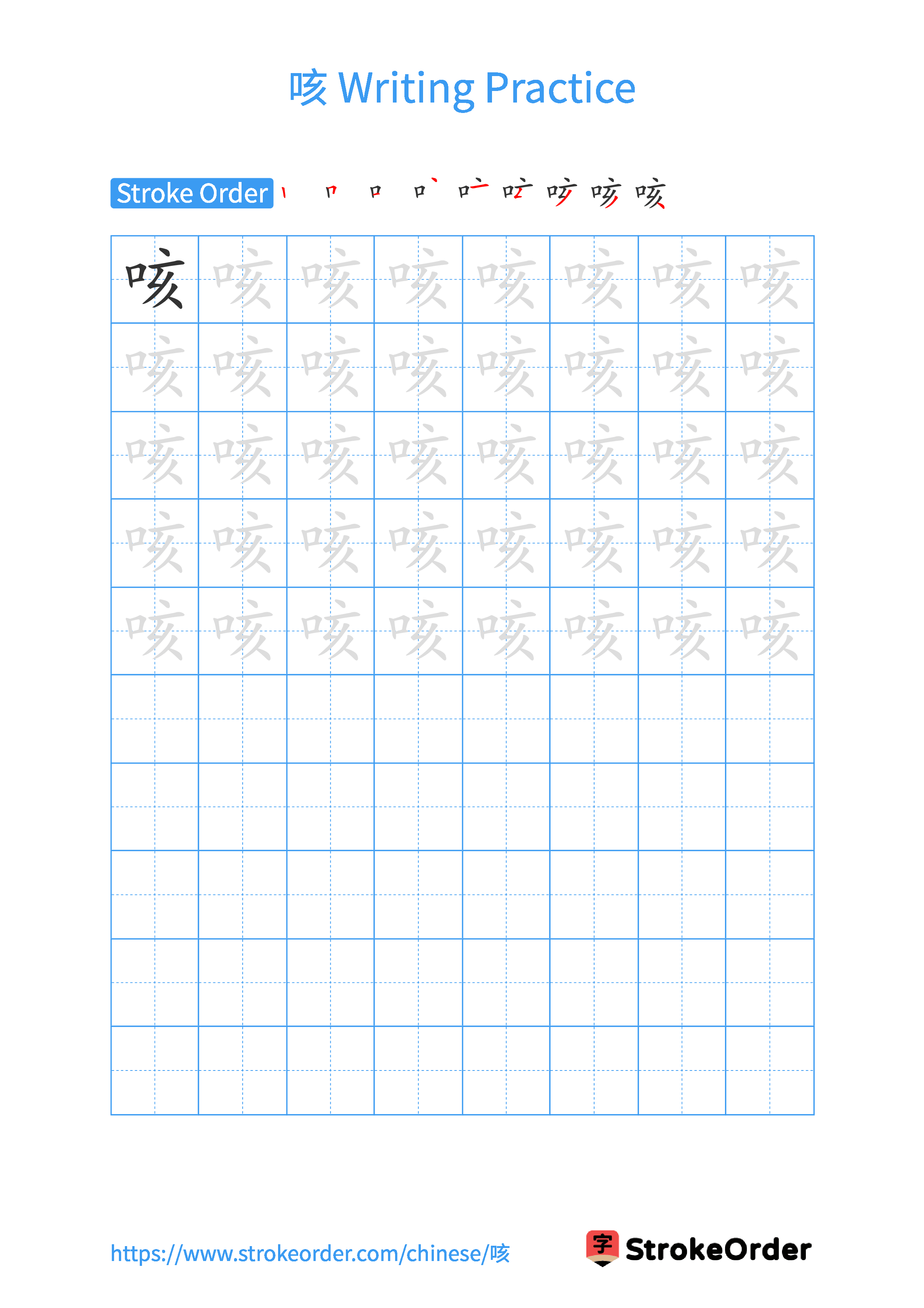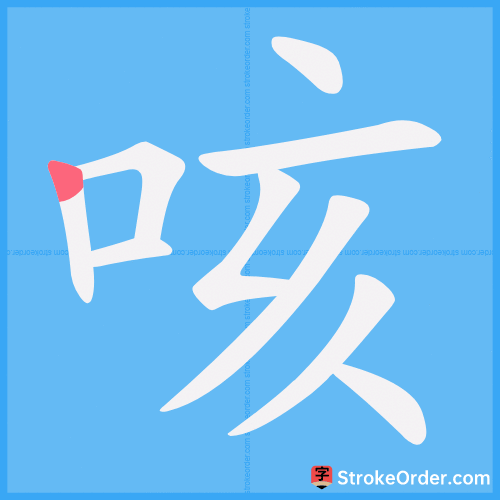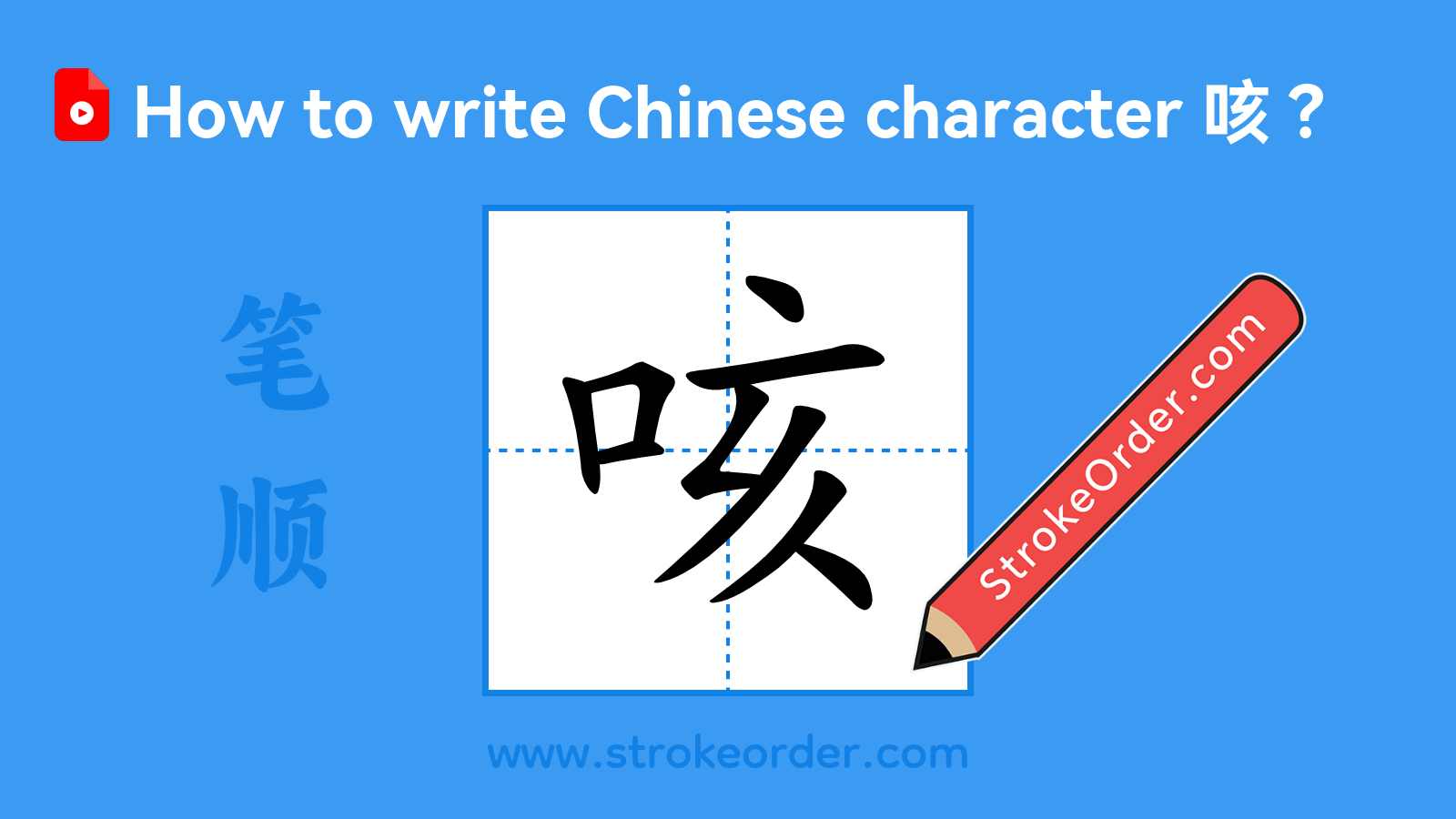咳 Stroke Order
Animated Stroke Order of 咳
Stroke Order Diagrams for 咳
Step-by-Step Handwriting Guide for 咳
Learn to Write Chinese Characters with Video Tutorials
Watch the video of writing the Chinese character "咳", learn the correct stroke order (笔顺) of the character "咳", and master the standard way of writing the character "咳".
Free Printable Handwriting Practice with Stroke Order: 咳
Printable Writing Practice Worksheet of "咳" in Portrait Orientation (Tian Zi Ge)

Printable Writing Practice Worksheet of "咳" in Landscape Orientation (Tian Zi Ge)

Information of 咳
Pinyinké、 hāi
Radical
口
Strokes
9 strokes
Usage
★★★★★
Definition
sound of sighing, cough
咳 (ké) 1. Cough: A reflex action triggered by irritation of the respiratory organs. It involves expelling inhaled air quickly while making a sound, which helps to clear away foreign objects or phlegm from the respiratory tract and is also a symptom of certain diseases.咳 (ké) 本义: 小儿笑。 (“Records of the Grand Historian - Bian Que’s Biography”: "Never reported to cough, the child was just laughing." (Cough child: Infants just starting to laugh.) 造字法:形声。从口,亥(hāi)声,①(hāi) 引: 1. Song - Su Shi “Record of Shizhong Mountain”: "As if the old man coughs and laughs in the valley." 例: 1. 咳唾 (to cough and spit saliva); 咳逆 (a kind of cough disease caused by reversed qi); 咳珠吐玉 (metaphor for beautiful wording); 咳血 (to cough up blood). 2. Sigh. 3. An exclamation word to express regret or remorse. 咳 (hāi) 叹: 1. 啊 ([En.] hi) — Used to express various emotions (such as joy, comfort, regret, or contempt). 2. 哎呀,唉,呜呼 ([En.] alas) — Used to express misfortune, sadness, regret, or concern. 3. 该死! 糟了! ([En.] damn it) — Used as a mild curse. 4. 表示感叹 ([En.] what). 5. 嗨 ([En.] hi) — Used to greet or attract attention. 咳 (hāi) 叹: 1. Sigh ([En.] sigh). 2. 另见 hái; ké. 咳 (hái) 1. 小儿笑 ([En.] child laugh). 2. Later refers to the expression of laughter. 3. 通“阂”。阻隔 ([En.] obstruct). 咳 (hái) 名: 1. 通“孩”。小儿 ([En.] child). 2. 另见 hāi; ké. 咳 (hái) 动: 1. 小儿笑 ([En.] child laugh). 引: 1. "Shuowen": 咳,小儿笑也。从口,亥声。 2. 后泛指笑貌。 例: 1. 如: 咳咳 (laughing appearance), 咳笑 (children laughing). 2. 通“阂”。阻隔 ([En.] obstruct). 引: 1. "Yanzi Chunyǔ": "The neck and tail cough in the universe."咳 (hái) 名: 1. 通“孩”。小儿 ([En.] child). 引: 1. "Records of the Grand Historian - Bian Que’s Biography”: "Never reported to cough to the infant's appearance." 例: 1. 如: 咳儿; 咳咳 (the appearance of a fetus); 咳婴 (refers to infants who have just started to laugh and still need nursing). *引自繁体辞典解释* 动: 1. Use force to cough, forcing obstructive objects to expel from the throat. Such as: "cough phlegm," "cough blood," "suddenly cough out a small fish bone."
hemoptysis
dry cough / hoose
to suppress coughing
to cough up phlegm / to expectorate
antitussive drug / antibechic
whooping cough / pertussis
Cough
to cough / CL:陣|阵[zhen4]
Input Method for 咳
Pinyinke2
Wubi
kynw
Cangjie
ryvo
Zhengma
jszo
Four Corner
60082
Unicode
U+54b3
Same Pronunciation Characters
克刻可咳坷壳客棵渴磕科苛蝌课颗剋嗑岢恪柯氪溘珂疴瞌稞窠缂轲锞颏骒髁峇痾課軻钶頦顆匼胢牁趷萪嵙搕犐鈳薖榼樖醘礚殻揢翗嶱炣渇敤嵑勀勊尅娔堁愙碦緙錁騍礊㕉㞹㵣㪼㪃㪡㪙㰤㤩㾧䙐䶗
Same Radical Characters
口古句另叨叩只叫召叭叮可台史右叶号司叹叼叽吁吃各吆合吉吊同名后吏吐向吓吕吗君吝吞吟吠否吧吨吩含听吭吮启吱吴吵吸吹吻吼吾呀呈告呐呕员呛呜周味呵呻呼命咄咋和咏咐咒咕咖咙咧咨咪咬咱咳咸咽哀品哄哆哇哈哉响哎
本文来自轻雾山林投稿,不代表汉字笔顺中文网英文版立场,如若转载,请注明出处:https://www.strokeorder.cn/strokeorder/18243.html





 微信扫一扫
微信扫一扫 